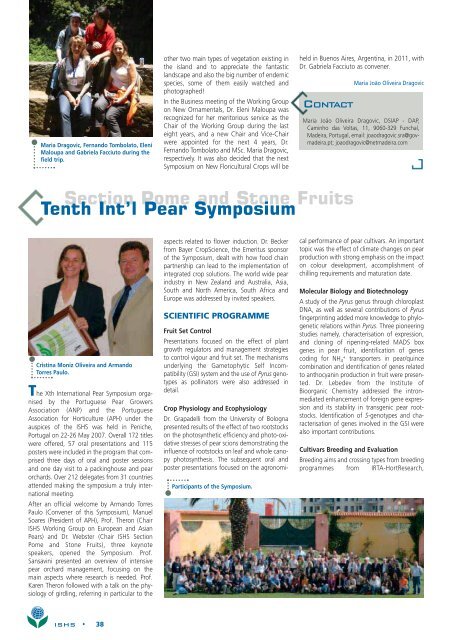Chronica - Acta Horticulturae
Chronica - Acta Horticulturae
Chronica - Acta Horticulturae
You also want an ePaper? Increase the reach of your titles
YUMPU automatically turns print PDFs into web optimized ePapers that Google loves.
Maria Dragovic, Fernando Tombolato, Eleni<br />
Maloupa and Gabriela Facciuto during the<br />
field trip.<br />
other two main types of vegetation existing in<br />
the island and to appreciate the fantastic<br />
landscape and also the big number of endemic<br />
species, some of them easily watched and<br />
photographed!<br />
In the Business meeting of the Working Group<br />
on New Ornamentals, Dr. Eleni Maloupa was<br />
recognized for her meritorious service as the<br />
Chair of the Working Group during the last<br />
eight years, and a new Chair and Vice-Chair<br />
were appointed for the next 4 years, Dr.<br />
Fernando Tombolato and MSc. Maria Dragovic,<br />
respectively. It was also decided that the next<br />
Symposium on New Floricultural Crops will be<br />
held in Buenos Aires, Argentina, in 2011, with<br />
Dr. Gabriela Facciuto as convener.<br />
CONTACT<br />
Maria João Oliveira Dragovic<br />
Maria João Oliveira Dragovic, DSIAP - DAP,<br />
Caminho das Voltas, 11, 9060-329 Funchal,<br />
Madeira, Portugal, email: joaodragovic.sra@govmadeira.pt;<br />
joaodragovic@netmadeira.com<br />
Section Pome and Stone Fruits<br />
Tenth Int’l Pear Symposium<br />
Cristina Moniz Oliveira and Armando<br />
Torres Paulo.<br />
The Xth International Pear Symposium organised<br />
by the Portuguese Pear Growers<br />
Association (ANP) and the Portuguese<br />
Association for Horticulture (APH) under the<br />
auspices of the ISHS was held in Peniche,<br />
Portugal on 22-26 May 2007. Overall 172 titles<br />
were offered, 57 oral presentations and 115<br />
posters were included in the program that comprised<br />
three days of oral and poster sessions<br />
and one day visit to a packinghouse and pear<br />
orchards. Over 212 delegates from 31 countries<br />
attended making the symposium a truly international<br />
meeting.<br />
After an official welcome by Armando Torres<br />
Paulo (Convener of this Symposium), Manuel<br />
Soares (President of APH), Prof. Theron (Chair<br />
ISHS Working Group on European and Asian<br />
Pears) and Dr. Webster (Chair ISHS Section<br />
Pome and Stone Fruits), three keynote<br />
speakers, opened the Symposium. Prof.<br />
Sansavini presented an overview of intensive<br />
pear orchard management, focusing on the<br />
main aspects where research is needed. Prof.<br />
Karen Theron followed with a talk on the physiology<br />
of girdling, referring in particular to the<br />
aspects related to flower induction. Dr. Becker<br />
from Bayer CropScience, the Emeritus sponsor<br />
of the Symposium, dealt with how food chain<br />
partnership can lead to the implementation of<br />
integrated crop solutions. The world wide pear<br />
industry in New Zealand and Australia, Asia,<br />
South and North America, South Africa and<br />
Europe was addressed by invited speakers.<br />
SCIENTIFIC PROGRAMME<br />
Fruit Set Control<br />
Presentations focused on the effect of plant<br />
growth regulators and management strategies<br />
to control vigour and fruit set. The mechanisms<br />
underlying the Gametophytic Self Incompatibility<br />
(GSI) system and the use of Pyrus genotypes<br />
as pollinators were also addressed in<br />
detail.<br />
Participants of the Symposium.<br />
Crop Physiology and Ecophysiology<br />
Dr. Grapadelli from the University of Bologna<br />
presented results of the effect of two rootstocks<br />
on the photosynthetic efficiency and photo-oxidative<br />
stresses of pear scions demonstrating the<br />
influence of rootstocks on leaf and whole canopy<br />
photosynthesis. The subsequent oral and<br />
poster presentations focused on the agronomical<br />
performance of pear cultivars. An important<br />
topic was the effect of climate changes on pear<br />
production with strong emphasis on the impact<br />
on colour development, accomplishment of<br />
chilling requirements and maturation date.<br />
Molecular Biology and Biotechnology<br />
A study of the Pyrus genus through chloroplast<br />
DNA, as well as several contributions of Pyrus<br />
fingerprinting added more knowledge to phylogenetic<br />
relations within Pyrus. Three pioneering<br />
studies namely, characterisation of expression,<br />
and cloning of ripening-related MADS box<br />
genes in pear fruit, identification of genes<br />
coding for NH 4+ transporters in pear/quince<br />
combination and identification of genes related<br />
to anthocyanin production in fruit were presented.<br />
Dr. Lebedev from the Institute of<br />
Bioorganic Chemistry addressed the intronmediated<br />
enhancement of foreign gene expression<br />
and its stability in transgenic pear rootstocks.<br />
Identification of S-genotypes and characterisation<br />
of genes involved in the GSI were<br />
also important contributions.<br />
Cultivars Breeding and Evaluation<br />
Breeding aims and crossing types from breeding<br />
programmes from IRTA-HortResearch,<br />
ISHS • 38
















